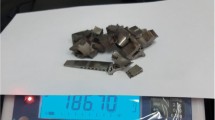Conclusions
The deposits in the study are multicomponent polydispersed suspensions characterized by a solid-phase concentration of 3.79–17.7% density 1–1.09 g/cm3, and a pH of 8.2–11.9. When the deposits are left to stand for 10 days they become compacted up to 40–70% of the original volume. The size of the aggregates of the dispersed phase change from 5 to 50 μm with a predominant particle size of 5 to 20 μm (64–79%). The electrokinetic potential of the phase is from −1.5 to −12.8 mV for various batches of deposits.
The dispersion medium of the deposits is characterized by a pH of 8–11.5; a density of 1 g/cm3; viscosity of 0.001 Pa·sec; an electrical resistivity of 7.8·10−4 to 44·10−4Ω−1·cm−1; and a concentration of dry residue up to 1490 mg/liter.
The dispersed phase of the deposits has a density of 2.16–2.52 g/cm3 and consists mainly of oxides of silicon, aluminum, calcium and a very small amount of oxides of titanium, iron, magnesium, and manganese.
The addition of polyacrylamide to the original deposits in amounts of 25 to 400 mg/liter leads to a reduction in the electrokinetic potential of the particles, to their aggregation, and to spatial structure-formation.
With the addition of polyacrylamide in amounts of 100–250 mg/liter to the deposits, the size of the aggregates decreases 15–30-fold by comparison with the untreated. The addition of PAA does not significantly affect the chemical composition of the dispersed phase.
The data in this paper have been used to plan the cleansing equipment at the Zaporozhe Refractory Plant.
Similar content being viewed by others
Literature cited
V. N. Ponomareva, “Concentrations of dispersions using an electric field,” Candidate's Dissertation, Leningrad (1975).
Soviet-American Symposium on the Treatment of Foul Water [in Russian], Moscow (1975).
A. Z. Evilevich, Utilization of the Deposits from Foul Water [in Russian], Stroiizdat, Moscow (1979).
I. S. Turovskii, Treatment of Deposits from Foul Water [in Russian], Stroiizdat, Moscow (1982).
O. N. Grigorov, I. F. Karpova, and Z. P. Koz'mina, in: Guide to Practical Work in Colloid Chemistry [in Russian], Khimiya, Leningrad (1964).
I. S. Lavrov and V. N. Ponomareva, Zh. Prikl. Khim.,50, No. 4, 785–789 (1977).
Author information
Authors and Affiliations
Additional information
Translated from Ogneupory, No. 5, pp. 30–33, May, 1984.
Rights and permissions
About this article
Cite this article
Ponomareva, V.N., Kuzina, T.M., Yakovleva, V.S. et al. Physicochemical properties of the deposits from the circulating water at the Zaporozhe Refractory Plant. Refractories 25, 300–304 (1984). https://doi.org/10.1007/BF01395841
Issue Date:
DOI: https://doi.org/10.1007/BF01395841




